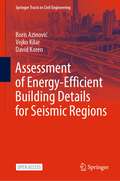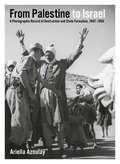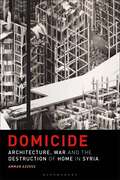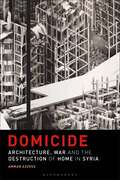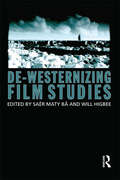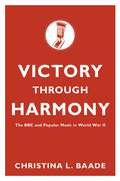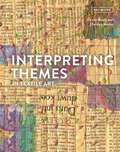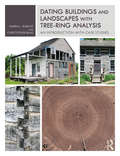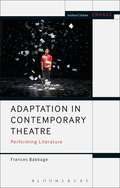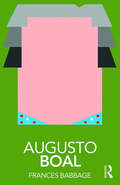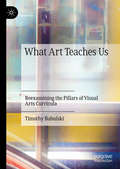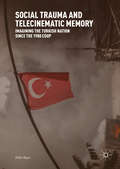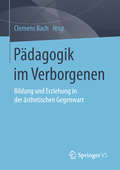- Table View
- List View
The Multi-Protagonist Film (New Approaches to Film Genre #16)
by María del AzconaThe Multi-Protagonist Film is an insightful and provocative introduction to this important new genre. Explores the origins and history of one of the most exciting new developments in contemporary film worldwide Guides readers through the genre’s central characteristics and conventions, as well as it's evolution and cultural relevance Provides a theoretical framework that is developed through the analysis several films, including Grand Hotel, Singles, American Pie, Short Cuts, and Syriana. Reveals the duality of the genre's contemporary preoccupations: the impact of globalization on human lives versus the current state of intimate affairs, the crisis of marriage, and the proliferation of sexual choices
Assessment of Energy-Efficient Building Details for Seismic Regions (Springer Tracts in Civil Engineering)
by Boris Azinović Vojko Kilar David KorenThis open access book presents a methodology for the assessment of structural building details, taking into account the contemporary guidelines for earthquake-resistant and energy-efficient buildings. A review of structural details for energy-efficient buildings revealed that in some cases the structural system is interrupted, leading to solutions which are not suitable for earthquake-prone regions. Such typical examples would be the use of thermal insulation under the building foundation and reduction of the load-bearing elements’ dimensions – also at the potential locations of plastic hinges which are crucial for the dissipation of seismic energy. The proposed methodology of assessment favours a collaboration of architects, engineers, contractors and investors in the early stage of building design. By this the methodology enables efficient decision-making and contributes to a selection of optimal building structural details.The book starts by presenting the typical structural details of the thermal envelope of energy-efficient buildings together with the scientific background required for understanding the process of detail development from all the relevant aspects. Over 20 examples of most frequent details are described and analysed to raise awareness of the importance of earthquake resistance, sustainability, energy-efficiency and thermal comfort for users.
The Civil Contract of Photography
by Ariella AzoulayIn this groundbreaking work, Ariella Azoulay thoroughly revises our understanding of the ethical status of photography. It must, she insists, be understood in its inseparability from the many catastrophes of recent history. She argues that photography is a particular set of relations between individuals and the powers that govern them and, at the same time, a form of relations among equals that constrains that power. Anyone, even a stateless person, who addresses others through photographs or occupies the position of a photograph’s addressee, is or can become a member of the citizenry of photography.The crucial arguments of the book concern two groups that have been rendered invisible by their state of exception: the Palestinian noncitizens of Israel and women in Western societies. Azoulay’s leading question is: Under what legal, political, or cultural conditions does it become possible to see and show disaster that befalls those with flawed citizenship in a state of exception? The Civil Contract of Photography is an essential work for anyone seeking to understand the disasters of recent history and the consequences of how they and their victims are represented.
From Palestine to Israel: A Photographic Record of Destruction and State Formation, 1947-1950
by Ariella AzoulayIn this carefully curated and beautifully presented photobook, Ariella Azoulay offers a new perspective on four crucial years in the history of Palestine/Israel.*BR**BR*The book reconstructs the processes by which the Palestinian majority in Mandatory Palestine became a minority in Israel, while the Jewish minority established a new political entity in which it became a majority ruling a minority Palestinian population. By reading over 200 photographs from that period, most of which were previously confined to Israeli state archives, Azoulay recounts the events and the stories that for years have been ignored or only partially acknowledged in Israel and the West.*BR**BR*Including substantial analytical text, this book will give activists, scholars and journalists a new perspective on the origins of the Palestine-Israel conflict.
Domicide: Architecture, War and the Destruction of Home in Syria
by Dr Ammar AzzouzThe city of Homs, like so many places in Syria, has suffered mass destruction since the war began in 2011. So far, the architectural response to the crisis has focused on 'cultural heritage', ancient architecture, and the external displacement of refugees, often neglecting the everyday lives of Syrians and the buildings that make up their homes and communities. In Domicide, Ammar Azzouz uses the notion of the 'home' to address the destruction in cities like Homs, the displacement of Syrian people both externally and internally, and to explore how cities can be rebuilt without causing further damage to the communities that live there.Drawing on interviews with those working in the built environment professions, both inside and outside of Syria, but also Syrians from other backgrounds who have become 'architects' in their own way as they were forced to repair and rebuild their homes by themselves, Domicide offers fresh insight into the role of the architect during time of war, and explores how the future reconstruction of cities should mirror the wants and needs, the traditions and ways of living, of local communities. Focusing on Homs but offering a blueprint for other urban areas of conflict across Syria and the wider world, the book is essential reading for researchers in architecture, urban planning, heritage studies and conflict studies.
Domicide: Architecture, War and the Destruction of Home in Syria
by Dr Ammar AzzouzThe city of Homs, like so many places in Syria, has suffered mass destruction since the war began in 2011. So far, the architectural response to the crisis has focused on 'cultural heritage', ancient architecture, and the external displacement of refugees, often neglecting the everyday lives of Syrians and the buildings that make up their homes and communities. In Domicide, Ammar Azzouz uses the notion of the 'home' to address the destruction in cities like Homs, the displacement of Syrian people both externally and internally, and to explore how cities can be rebuilt without causing further damage to the communities that live there.Drawing on interviews with those working in the built environment professions, both inside and outside of Syria, but also Syrians from other backgrounds who have become 'architects' in their own way as they were forced to repair and rebuild their homes by themselves, Domicide offers fresh insight into the role of the architect during time of war, and explores how the future reconstruction of cities should mirror the wants and needs, the traditions and ways of living, of local communities. Focusing on Homs but offering a blueprint for other urban areas of conflict across Syria and the wider world, the book is essential reading for researchers in architecture, urban planning, heritage studies and conflict studies.
De-Westernizing Film Studies
by Saër Maty Bâ Will HigbeeDe-Westernizing Film Studies aims to consider what form a challenge to the enduring vision of film as a medium - and film studies as a discipline - modelled on ‘Western’ ideologies, theoretical and historical frameworks, critical perspectives as well as institutional and artistic practices, might take today. The book combines a range of scholarly writing with critical reflection from filmmakers, artists & industry professionals, comprising experience and knowledge from a wide range of geographical areas, film cultures and (trans-)national perspectives. In their own ways, the contributors to this volume problematize a binary mode of thinking that continues to promote an idea of ‘the West and the rest’ in relation to questions of production, distribution, reception and representation within an artistic medium (cinema) that, as part of contemporary moving image culture, is more globalized and diversified than at any time in its history. In so doing, De-Westernizing Film Studies complicates and/or re-thinks how local, national and regional film cultures ‘connect’ globally, seeking polycentric, multi-directional, non-essentialized alternatives to Eurocentric theoretical and historical perspectives found in film as both an artistic medium and an academic field of study. The book combines a series of chapters considering a range of responses to the idea of 'de-westernizing' film studies with a series of in-depth interviews with filmmakers, scholars and critics. Contributors: Nathan Abrams, John Akomfrah, Saër Maty Bâ, Mohammed Bakrim, Olivier Barlet, Yifen Beus, Farida Benlyazid, Kuljit Bhamra, William Brown, Campbell, Jonnie Clementi-Smith, Shahab Esfandiary, Coco Fusco, Patti Gaal-Holmes, Edward George, Will Higbee, Katharina Lindner, Daniel Lindvall, Teddy E. Mattera, Sheila Petty, Anna Piva, Deborah Shaw, Rod Stoneman, Kate E. Taylor-Jones
De-Westernizing Film Studies
by Saer Maty Ba Will HigbeeDe-Westernizing Film Studies aims to consider what form a challenge to the enduring vision of film as a medium - and film studies as a discipline - modelled on ‘Western’ ideologies, theoretical and historical frameworks, critical perspectives as well as institutional and artistic practices, might take today. The book combines a range of scholarly writing with critical reflection from filmmakers, artists & industry professionals, comprising experience and knowledge from a wide range of geographical areas, film cultures and (trans-)national perspectives. In their own ways, the contributors to this volume problematize a binary mode of thinking that continues to promote an idea of ‘the West and the rest’ in relation to questions of production, distribution, reception and representation within an artistic medium (cinema) that, as part of contemporary moving image culture, is more globalized and diversified than at any time in its history. In so doing, De-Westernizing Film Studies complicates and/or re-thinks how local, national and regional film cultures ‘connect’ globally, seeking polycentric, multi-directional, non-essentialized alternatives to Eurocentric theoretical and historical perspectives found in film as both an artistic medium and an academic field of study. The book combines a series of chapters considering a range of responses to the idea of 'de-westernizing' film studies with a series of in-depth interviews with filmmakers, scholars and critics. Contributors: Nathan Abrams, John Akomfrah, Saër Maty Bâ, Mohammed Bakrim, Olivier Barlet, Yifen Beus, Farida Benlyazid, Kuljit Bhamra, William Brown, Campbell, Jonnie Clementi-Smith, Shahab Esfandiary, Coco Fusco, Patti Gaal-Holmes, Edward George, Will Higbee, Katharina Lindner, Daniel Lindvall, Teddy E. Mattera, Sheila Petty, Anna Piva, Deborah Shaw, Rod Stoneman, Kate E. Taylor-Jones
Victory through Harmony: The BBC and Popular Music in World War II
by Christina L. BaadeTo serve the British nation in World War II, the BBC charged itself with mobilizing popular music in support of Britain's war effort. Radio music, British broadcasters and administrators argued, could maintain civilian and military morale, increase industrial production, and even promote a sense of Anglo-American cooperation. Because of their widespread popularity, dance music and popular song were seen as ideal for these tasks; along with jazz, with its American associations and small but youthful audience, these genres suddenly gained new legitimacy at the traditionally more conservative BBC. In Victory through Harmony, author Christina Baade both tells the fascinating story of the BBC's musical participation in wartime events and explores how popular music and jazz broadcasting helped redefine notions of war, gender, race, class, and nationality in wartime Britain. Baade looks in particular at the BBC's pioneering Listener Research Department, which tracked the tastes of select demographic groups including servicemen stationed overseas and young female factory workers in order to further the goal of entertaining, cheering, and even calming the public during wartime. The book also tells how the wartime BBC programmed popular music to an unprecedented degree with the goal of building national unity and morale, promoting new roles for women, virile representations of masculinity, Anglo-American friendship, and pride in a common British culture. In the process, though, the BBC came into uneasy contact with threats of Americanization, sentimentality, and the creativity of non-white "others," which prompted it to regulate and even censor popular music and performers. Rather than provide the soundtrack for a unified "People's War," Baade argues, the BBC's broadcasting efforts exposed the divergent ideologies, tastes, and perspectives of the nation. This illuminating book will interest all readers in popular music, jazz, and radio, as well as British cultural history and gender studies.
Interpreting Themes in Textile Art
by Els Van Baarle Cherilyn MartinAn inspirational and practical book on how to interpret and collaborate on different themes in textile art. With foreword by Marie-Therese Wisniowski, who runs Art Quill Studio. This stunning collection showcases the work produced by renowned textile artists Els van Baarle and Cherilyn Martin, and explores how – even when working from the same starting point – textile art can produce a myriad interpretations of shape, form, colour and technique. Els and Cherilyn have chosen six themes for their own starting point, each full of inspiration and artistic potential: Memory (both personal experiences and historical events); Graven (cemetery) images and idols; Books as objects; Pompeii and archaeological excavations; Walls; and Everyday items. For each of the themes the authors have provided a personal interpretation of the work and a description of the techniques they used, along with step-by-step instructions. In the chapter on memory, for example, Cherilyn demonstrates how old fabrics and textiles (which themselves have a unique history all of their own) can be recycled to incorporate your own stitched drawings. Alternatively, Els explores Procion Dye techniques to create colourful and striking fabrics that bear no resemblance to Els work on the same theme. The trend for collaborative textile art is increasing in popularity. This fascinating guide provides a rich seam of inspiration from two renowned artists, exploring how to get the most from your collaborations and produce beautiful and unique work.
Dating Buildings and Landscapes with Tree-Ring Analysis: An Introduction with Case Studies
by Christopher Baas Darrin L. RubinoThis book presents guidance, theory, methodologies, and case studies for analyzing tree rings to accurately date and interpret historic buildings and landscapes. Written by two long-time practitioners in the field of dendrochronology, the research is grounded in the fieldwork data of approximately 200 structures and landscapes. By scientifically analyzing the tree rings of historic timbers, preservationists can obtain valuable information about construction dates, interpret the evolution of landscapes and buildings over time, identify species and provenance, and gain insight into the species matrix of local forests. Authors Darrin L. Rubino and Christopher Baas demonstrate, through full-color illustrated case studies and methodologies, how this information can be used to interpret the history of buildings and landscapes and assist preservation decision-making. Over 1,000 samples obtained from more than 40 buildings, including high style houses, vernacular log houses, and timber frame barns, are reported. This book will be particularly relevant for students, instructors, and professional readers interested in historic preservation, cultural landscapes, museum studies, archaeology, and dendrochronology globally.
Dating Buildings and Landscapes with Tree-Ring Analysis: An Introduction with Case Studies
by Christopher Baas Darrin L. RubinoThis book presents guidance, theory, methodologies, and case studies for analyzing tree rings to accurately date and interpret historic buildings and landscapes. Written by two long-time practitioners in the field of dendrochronology, the research is grounded in the fieldwork data of approximately 200 structures and landscapes. By scientifically analyzing the tree rings of historic timbers, preservationists can obtain valuable information about construction dates, interpret the evolution of landscapes and buildings over time, identify species and provenance, and gain insight into the species matrix of local forests. Authors Darrin L. Rubino and Christopher Baas demonstrate, through full-color illustrated case studies and methodologies, how this information can be used to interpret the history of buildings and landscapes and assist preservation decision-making. Over 1,000 samples obtained from more than 40 buildings, including high style houses, vernacular log houses, and timber frame barns, are reported. This book will be particularly relevant for students, instructors, and professional readers interested in historic preservation, cultural landscapes, museum studies, archaeology, and dendrochronology globally.
Iran After the Mongols (The Idea of Iran)
by Sussan BabaieFollowing the devastating Mongol conquest of Baghdad in 1258, the domination of the Abbasids declined leading to successor polities, chiefly among them the Ilkhanate in Greater Iran, Iraq and the Caucasus. Iranian cultural identities were reinstated within the lands that make up today's Iran, including the area of greater Khorasan. The Persian language gained unprecedented currency over Arabic and new buildings and manuscripts were produced for princely patrons with aspirations to don the Iranian crown of kingship. This new volume in “The Idea of Iran” series follows the complexities surrounding the cultural reinvention of Iran after the Mongol invasions, but the book is unique capturing not only the effects of Mongol rule but also the period following the collapse of Mongol-based Ilkhanid rule. By the mid-1330s the Ilkhanate in Iran was succeeded by alternative models of authority and local Iranian dynasties. This led to the proliferation of diverse and competing cultural, religious and political practices but so far scholarship has neglected to produce an analysis of this multifaceted history in any depth. Iran After the Mongols offers new and cutting-edge perspectives on what happened. Analysing the fourteenth century in its own right, Sussan Babaie and her fellow contributors capture the cultural complexity of an era that produced some of the most luminous masterpieces in Persian literature and the most significant new building work in Tabriz, Yazd, Herat and Shiraz. Featuring contributions by leading scholars, this is a wide-ranging treatment of an under-researched period and the volume will be essential reading for scholars of Iranian Studies and Middle Eastern History.
Adaptation in Contemporary Theatre: Performing Literature (Methuen Drama Engage)
by Frances BabbageWhy are so many theatre productions adaptations of one kind or another? Why do contemporary practitioners turn so frequently to non-dramatic texts for inspiration? This study explores the fascination of novels, short stories, children's books and autobiographies for theatre makers and examines what 'becomes' of literary texts when these are filtered into contemporary practice that includes physical theatre, multimedia performance, puppetry, immersive and site-specific performance and live art.In Adaptation in Contemporary Theatre, Frances Babbage offers a series of fresh critical perspectives on the theory of adaptation in theatre-making, focusing on meditations of prose literature within contemporary performance. Individual chapters explore the significance and impact of books as physical objects within productions; the relationship between the dramatic adaptation and literary edition; storytelling on the page and in performance; literary space and theatrical space; and prose fiction reframed as 'found text' in contemporary theatre and live art. Case studies are drawn from internationally acclaimed companies including Complicite, Elevator Repair Service, Kneehigh, Forced Entertainment, Gob Squad, Teatro Kismet and Stan's Cafe.Adaptation in Contemporary Theatre is a compelling and provocative resource for anyone interested in the potential and the challenges of using prose literature as material for new theatrical performance.
Adaptation in Contemporary Theatre: Performing Literature (Methuen Drama Engage)
by Frances BabbageWhy are so many theatre productions adaptations of one kind or another? Why do contemporary practitioners turn so frequently to non-dramatic texts for inspiration? This study explores the fascination of novels, short stories, children's books and autobiographies for theatre makers and examines what 'becomes' of literary texts when these are filtered into contemporary practice that includes physical theatre, multimedia performance, puppetry, immersive and site-specific performance and live art.In Adaptation in Contemporary Theatre, Frances Babbage offers a series of fresh critical perspectives on the theory of adaptation in theatre-making, focusing on meditations of prose literature within contemporary performance. Individual chapters explore the significance and impact of books as physical objects within productions; the relationship between the dramatic adaptation and literary edition; storytelling on the page and in performance; literary space and theatrical space; and prose fiction reframed as 'found text' in contemporary theatre and live art. Case studies are drawn from internationally acclaimed companies including Complicite, Elevator Repair Service, Kneehigh, Forced Entertainment, Gob Squad, Teatro Kismet and Stan's Cafe.Adaptation in Contemporary Theatre is a compelling and provocative resource for anyone interested in the potential and the challenges of using prose literature as material for new theatrical performance.
Augusto Boal (Routledge Performance Practitioners)
by Frances BabbageThis newly-updated volume looks at the scope of Augusto Boal's career from his early work as a playwright and director in Sao Paulo in the 1950s, to the development of his ground-breaking manifesto in the 1970s for a 'Theatre of the Oppressed'. Offering fascinating reading for anyone interested in the role that theatre can play in stimulating social and personal change, this useful study includes: a biographical and historical overview of Boal's career as theatre practitioner and director an in-depth analysis of Boal's classic text on radical theatre an exploration of training and production techniques practical guidance to Boal's workshop methods This is an essential introduction to the work of a practitioner who has had a tremendous impact on contemporary theatre. As a first step towards critical understanding, and as an initial exploration before going on to further, primary research, Routledge Performance Practitioners are unbeatable value for today’s student.
Augusto Boal (Routledge Performance Practitioners)
by Frances BabbageThis newly-updated volume looks at the scope of Augusto Boal's career from his early work as a playwright and director in Sao Paulo in the 1950s, to the development of his ground-breaking manifesto in the 1970s for a 'Theatre of the Oppressed'. Offering fascinating reading for anyone interested in the role that theatre can play in stimulating social and personal change, this useful study includes: a biographical and historical overview of Boal's career as theatre practitioner and director an in-depth analysis of Boal's classic text on radical theatre an exploration of training and production techniques practical guidance to Boal's workshop methods This is an essential introduction to the work of a practitioner who has had a tremendous impact on contemporary theatre. As a first step towards critical understanding, and as an initial exploration before going on to further, primary research, Routledge Performance Practitioners are unbeatable value for today’s student.
What Art Teaches Us: Reexamining the Pillars of Visual Arts Curricula
by Timothy BabulskiThis book critically examines four areas common to visual arts curricula: the elements of art and principles of design, the canons of human proportions, linear perspective, and RYB color theory. For each, the author presents a compelling case detailing how current art teaching fails students, explores the history of how it came to be part of the discourse, and then proffers cognitivist and holistic alternatives. This book provides a framework for teachers and teacher-candidates to shape how they advocate for intellectual rigor and embodied learning and, importantly, how they can subvert an existing curriculum to better meet the educational needs of their students.
Computational Topology in Image Context: 6th International Workshop, CTIC 2016, Marseille, France, June 15-17, 2016, Proceedings (Lecture Notes in Computer Science #9667)
by Alexandra Bac Jean-Luc MariThis book constitutes the proceedings of the 6th International Workshop on Computational Topology in Image Context, CTIC 2016, held in Marseille, France, in June 2016. The 24 papers presented in this volume were carefully reviewed and selected from 35 submissions. Additionally, this volume contains 2 invited papers. CTIC covers a wide range of topics such as: topological invariants and their computation, homology, cohomology, linking number, fundamental groups; algorithm optimization in discrete geometry, transfer of mathematical tools, parallel computation in multi-dimensional volume context, hierarchical approaches; experimental evaluation of algorithms and heuristics; combinatorial or multi-resolution models; discrete or computational topology; geometric modeling guided by topological constraints; computational topological dynamics; and use of topological information in discrete geometry applications.
Social Trauma and Telecinematic Memory: Imagining the Turkish Nation since the 1980 Coup
by Pelin BaşcıThis book explores responses to authoritarianism in Turkish society through popular culture by examining feature films and television serials produced between 1980 and 2010 about the 1980 coup. Envisioned as an interdisciplinary study in cultural studies rather than a disciplinary work on cinema, the book advocates for an understanding of popular culture in discerning emerging narratives of nationhood. Through feature films and television serials directly dealing with the coup of 1980, the book exposes tropes and discursive continuities such as “childhood” and “the child”. It argues that these conventional tropes enable popular debates on the modern nation’s history and its myths of identity.
Social Trauma and Telecinematic Memory: Imagining the Turkish Nation since the 1980 Coup
by Pelin BaşcıThis book explores responses to authoritarianism in Turkish society through popular culture by examining feature films and television serials produced between 1980 and 2010 about the 1980 coup. Envisioned as an interdisciplinary study in cultural studies rather than a disciplinary work on cinema, the book advocates for an understanding of popular culture in discerning emerging narratives of nationhood. Through feature films and television serials directly dealing with the coup of 1980, the book exposes tropes and discursive continuities such as “childhood” and “the child”. It argues that these conventional tropes enable popular debates on the modern nation’s history and its myths of identity.
Pädagogik im Verborgenen: Bildung und Erziehung in der ästhetischen Gegenwart
by Clemens BachDer Sammelband verfolgt das Ziel, gegenwärtige ästhetische Praktiken und die damit verbundenen konkreten ästhetischen Objekte und theoretischen Diskurse auf ihre implizite pädagogische Struktur hin zu befragen. Mittels interpretatorischer Bemühungen wird der Versuch unternommen zu überprüfen, inwiefern sich durch pädagogisch-theoretische Zugänge ein Intentionscharakter der jeweils zu betrachtenden Forschungsgegenstände sichtbar machen lässt. Im Verborgenen, so die These des Bandes, spielen sich solche Praktiken, Theorien und Objekte deshalb ab, da sie mittels verschiedener Strategien und hauptsächlich unter der Verwendung der Chiffre des Ästhetischen den Schein des Nicht-Intentionalen, des nicht gezielten Einwirkens auf adressierte Personen konstruieren.
Nordic Artificial Intelligence Research and Development: Third Symposium of the Norwegian AI Society, NAIS 2019, Trondheim, Norway, May 27–28, 2019, Proceedings (Communications in Computer and Information Science #1056)
by Kerstin Bach Massimiliano RuoccoThis book constitutes the refereed proceedings of the Third Symposium of the Norwegian AI Society, NAIS 2019, held in Trondheim, Norway, in May, 2019. The 11 full papers and 3 short papers were carefully reviewed and selected from 21 submissions. The papers focus on all aspects of: artificial intelligence; machine learning; knowledge representation; robotics; planning and scheduling; natural language processing; computer vision; search algorithms; multi-agent-systems; industrial applications; and philosophical and ethical foundations.
Collaborative Art in the Twenty-First Century (Routledge Advances in Art and Visual Studies)
by Sondra Bacharach Jeremy Neil Booth Siv B. FjærestadCollaboration in the arts is no longer a conscious choice to make a deliberate artistic statement, but instead a necessity of artistic survival. In today’s hybrid world of virtual mobility, collaboration decentralizes creative strategies, enabling artists to carve new territories and maintain practice-based autonomy in an increasingly commercial and saturated art world. Collaboration now transforms not only artistic practices but also the development of cultural institutions, communities and personal lifestyles. This book explores why collaboration has become so integrated into a greater understanding of creative artistic practice. It draws on an emerging generation of contributors—from the arts, art history, sociology, political science, and philosophy—to engage directly with the diverse and interdisciplinary nature of collaborative practice of the future.
Collaborative Art in the Twenty-First Century (Routledge Advances in Art and Visual Studies)
by Sondra Bacharach Siv B. Fjærestad Jeremy Neil BoothCollaboration in the arts is no longer a conscious choice to make a deliberate artistic statement, but instead a necessity of artistic survival. In today’s hybrid world of virtual mobility, collaboration decentralizes creative strategies, enabling artists to carve new territories and maintain practice-based autonomy in an increasingly commercial and saturated art world. Collaboration now transforms not only artistic practices but also the development of cultural institutions, communities and personal lifestyles. This book explores why collaboration has become so integrated into a greater understanding of creative artistic practice. It draws on an emerging generation of contributors—from the arts, art history, sociology, political science, and philosophy—to engage directly with the diverse and interdisciplinary nature of collaborative practice of the future.

